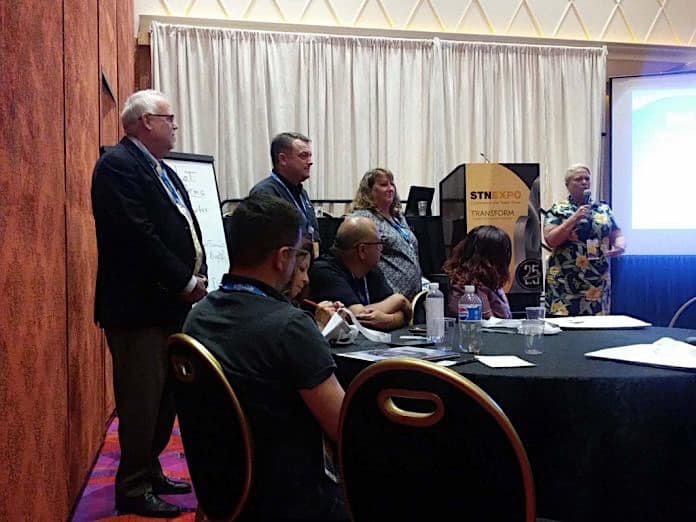RENO, Nev. — STN EXPO attendees with goals in mind came to learn from a panel of three directors of student transportation with decades of experience in the field.
- Related: Another Great Speaker at TSD; Early Bird Special Ends Friday
- Related: TSD Conference Highlights for Day 3 — Sunday, March 17
- Related: TSD Conference Highlights for Day 2 — Saturday, March 16
- Related: TSD Conference Highlights for Day 1 — Friday, March 15
- Related: Star Speaker Patrick Mulick Returns to TSD Conference
- Related: TSD Conference Speakers Set
The Saturday afternoon session was facilitated by Alexandra Robinson, executive director of the Office of Pupil Transportation at the New York City Department of Education. The three presenters were Chris Ellison, Pam McDonald and Timothy Purvis.
Ellison has been a transportation director in Oregon for almost 13 years, first at Greater Albany Public Schools and currently at Eugene Public Schools. McDonald has worked for California’s Orange Unified School District since 1986, and been director of transportation there for the last 22 years. She is also a former STN EXPO co-chair. Purvis, transportation director for Poway (California) USD, has been with the district for 28 years. All three are or were heavily involved in pupil transportation at the state level.
Most of the 62 attendees involved in the training have 10-30 years of experience in the industry. Many started as a school bus driver and had worked their way up to some sort of supervisory position, holding several jobs on the way. Several are currently dispatchers or driver trainers, and some had recently attained a leadership position in transportation.
Internal and External
As nearly all of the attendees in the room either desired to be a transportation supervisor or had recently been promoted to such a position within the last three years, the first part of the session focused on building a strong internal culture. The session featured the speakers sharing things that they wished they had known when they first attained their position.
Ellison stated that you must not only have a vision, but also create the buy-in. This is done by building relationships, especially with other transportation directors, since “we’ve all got the same issues,” as well as with principals and other district leadership, since supervisors work closely with them on student issues.
For successful relationships with employees and unions, he said, don’t ramrod new policies through but strike a balance with things that really need to change. Ellison also suggested having face-to-face monthly meetings to give employees “kudos” or rewards, as well as to take employee feedback. And do so with sincerity, added Robinson.
For those whose employee hours vary, McDonald said she uses the once-a-year in-service meeting to do something similar. “Make the time for it,” Ellison concurred.
Ellison also said that he drives a route for one person who wins a monthly drawing, allowing the driver to spend the route chatting with the kids. He shells out his personal money for gift cards for his drivers, and doesn’t exclude his monitors and office staff. Recognition feels good, so pay it forward, he stated.
The team mentality is one that must be fostered throughout the industry, added McDonald. “When something happens in the school bus community, it happens to all of us. We all take the hit,” stated McDonald. “When you see it on the news, come up with an answer, because you will get asked the question.”
For an effective team, some people have to get off the bus, said Ellison. He concurred with the point an attendee made that correction and training should always be the initial recourses to an employee’s poor behavior.
Robinson spoke of an exercise she conducts with transportation directors coming to her about problematic drivers or attendants. She questions if they would right now put their child on a bus with that person, and if they hesitate, then they need to remove that person from working on a school bus.
“We are a self-regulated industry because of the strength of our organizations” and our willingness to make tough decisions for its health, said Robinson. What one yellow school bus does reflects on the whole transportation department, McDonald said. Purvis and Ellison recommended carefully building the team and making sure people are in the right positions for them.
Proper relationships with unions make it easier to get rid of bad drivers, because, as Ellison said, union reps have admitted to him, “you can’t defend stupid.”
“Those relationships are so important,” Robinson said. “We are still all together in the business of education.”
“We are all on the same team,” Ellison agreed. “The sign of a true leader is that you can bring everyone together and you’re doing what’s right for student success.”
He stated that the most important part of this is displaying good customer service toward students, parents, staff, the district and others.
Why You Need Data Collection and KPIs
 A roleplay exercise the panelists held next took the form of a short skit in which a new and woefully underprepared transportation director appeared before the school board.
A roleplay exercise the panelists held next took the form of a short skit in which a new and woefully underprepared transportation director appeared before the school board.
Based on scenarios presented, Robinson advised new directors on some simple tips they could implement to be better prepared and make a better impression on school boards and the community members attending their meetings. Those tips include: Dress the part, be on time, have handouts or a flash drive, know the numbers and the math, provide some personable information on your department, and add value, by relating what your department does to what the likely uninformed school board members would prefer.
Purvis cautioned that elevating good drivers to supervisory roles simply because they are good at what they do and without proper mentoring, results in student transportation leaders being ill-prepared for their new roles. For new transportation directors to make informed decisions, they need to effectively measure data and turn it into Key Performance Indicators (KPIs), he said.
He recommended monitoring Average Daily Attendance, enrollment numbers, Full-Time Equivalent, monthly payroll, special education vs. regular routes, number of routes, fuel usage and school bell schedules. Attendees added additional areas including the absentee rate, damage to buses, overtime, retention rates, vehicle maintenance, competitiveness of wages, community complaints, and compliance with federal and state regulations.
Purvis pointed out that if these data points were monitored, they could reveal areas requiring additional training, or discover that the real reasons for a problem were different from those that were originally assumed.
“[The world] is changing, folks; change along with it,” he reminded. But “don’t collect data for the sake of collecting data, collect the data you need.”
He also spoke of the importance of breaking down the budget by separating costs. For example, this assists in being prepared for questions that are posed at school board meetings.
Scenario-Based Brainstorming
Robinson next asked attendees at each table in the room to discuss and come up with a hypothetical situation featuring a piece of data that they did not know but should know, and how they could find that information out.
One table of attendees pointed out that leaders won’t know everything, but should keep track of who would know, because they may have prepared the information before and it may be readily accessible.
If you’re asked for information, don’t go to extreme lengths to immediately gather it, but give a reasonable timeframe in which you will collect it, advised Robinson. “Because when you rush, you make mistakes,” or may be conducting double work, since someone else in another department may have it.
Another table discussed how drivers often have on-the-ground insight on real data, rather than what is said on paper or what district administration thinks.
Yet another table examined the example of school bus tires. Being efficient in tire replacement requires knowing how much tread is left in your current tires, which would then be wasted if an eager vendor offered a complete replacement, they said. Purvis agreed and pointed out that outsourcing tire maintenance, as some California district do, can cause the same problem.
Coupling local district data with national federal and association data sheds light on safety statistics, such as student injuries or fatalities while crossing the street, a different table said. Robinson cautioned against presenting data in a light that called safety into question, but said to rather present it from the perspective of the high level of safety already present.
When planning evacuation drills, accurate information must be obtained from drivers on ridership, special education equipment in use, and other related points, stated another table.
Technology solutions, a myriad of which are currently available, greatly assist with quickly gathering data points, like an accurate number of who was on a bus at any specific time, Purvis said.
Another table found that having room for error is an important part of running any daily operation.
One table brought up discipline referral rates. These, the panelists said, may take a few weeks to collect if the records are not kept electronically, and often they are not being analyzed to make actionable use of those data points.
“A good supervisor waits to answer until he has all the relevant data,” declared Robinson. She also advised to ask additional questions to correctly ascertain what exactly is being required and also to give themselves more time. “Figure out what you don’t know and where you can learn it,” she advised.
Public Relations and Leadership
“It’s very good to be visible” around the district and bus garage, McDonald said, as well as to invite school district officials to see the behind-the-scenes workings of the transportation department.
“You definitely have to brag about your department, so you’re out there,” she declared. Publicizing records or awards won, highlighting specific school bus drivers, providing quotes to the media when approved by the district, and involving the district and community in School Bus Safety Week and School Bus Driver Day, are all ways to do that.
Inviting other department heads like Programs or Health Services to talk to transportation “gets the word out that transportation is involved.” Similarly, swapping training instructors among nearby districts provides fresh perspectives that get drivers more involved.
“Be proactive, don’t be reactive, McDonald said. Don’t neglect training on equipment that your drivers use, post safety signs, and make sure that drivers and mechanics are safe on the job, to forestall injuries, HR problems, or bad PR.
Also, never stop looking to the future, said Robinson. “A good leader is always getting ready to organize themselves out,” she declared. Don’t let your standards, attitude or motivation slack over time, either. “You can be very realistic without being cynical,” she added.
A beautiful thing about the school bus industry is that “we all do the same thing, but we do it all differently,” said McDonald.
“Don’t necessarily just take the advice of what the vendor says you need—go to your neighbor,” a transportation director you know, advised Purvis.
Cultivating these relationships yields valuable dividends of both a personal and professional nature, Robinson added. “If you don’t have that passion for what you’re doing, you’re never going to be able to spread it to anybody else,” she reminded.














